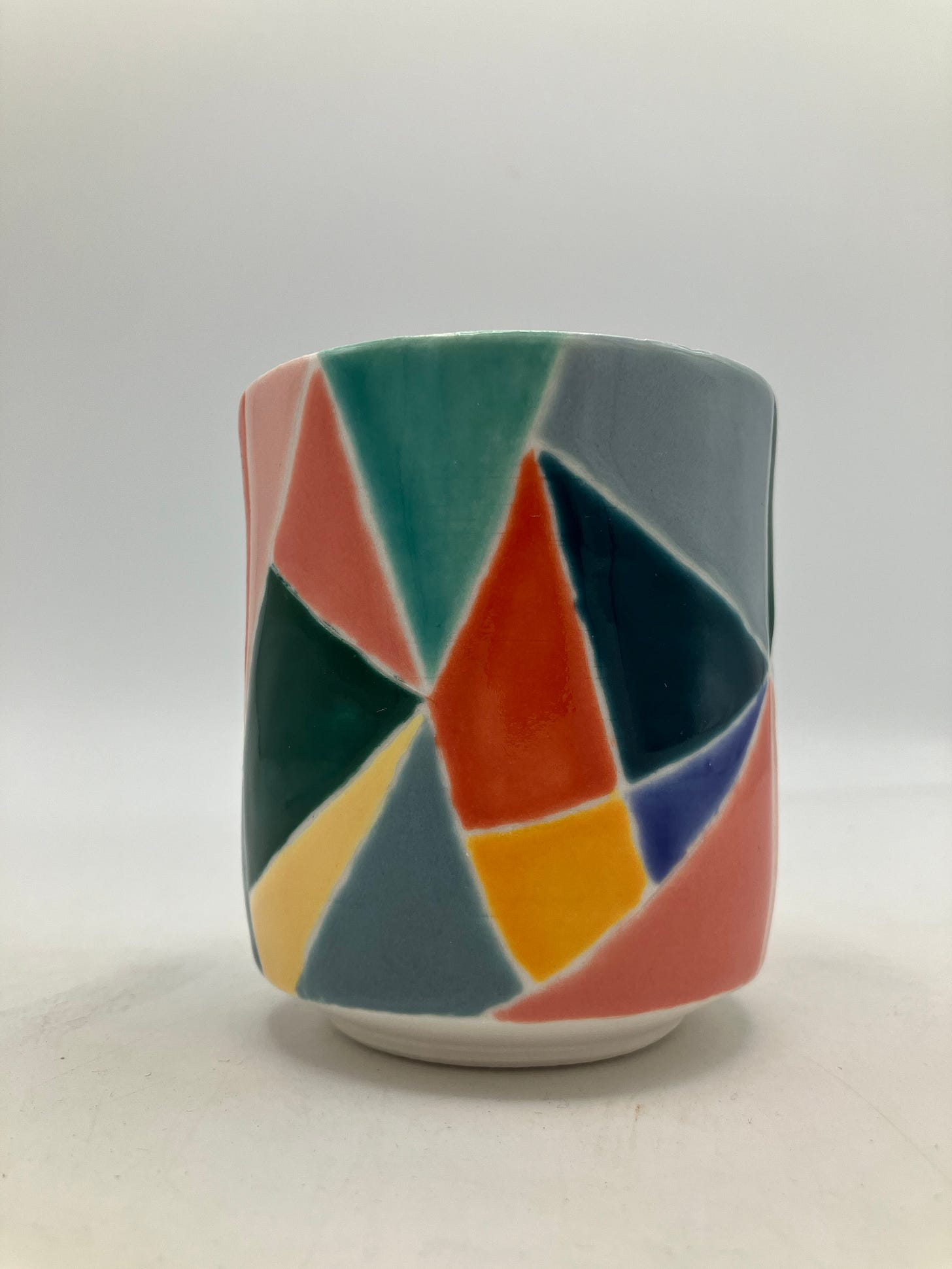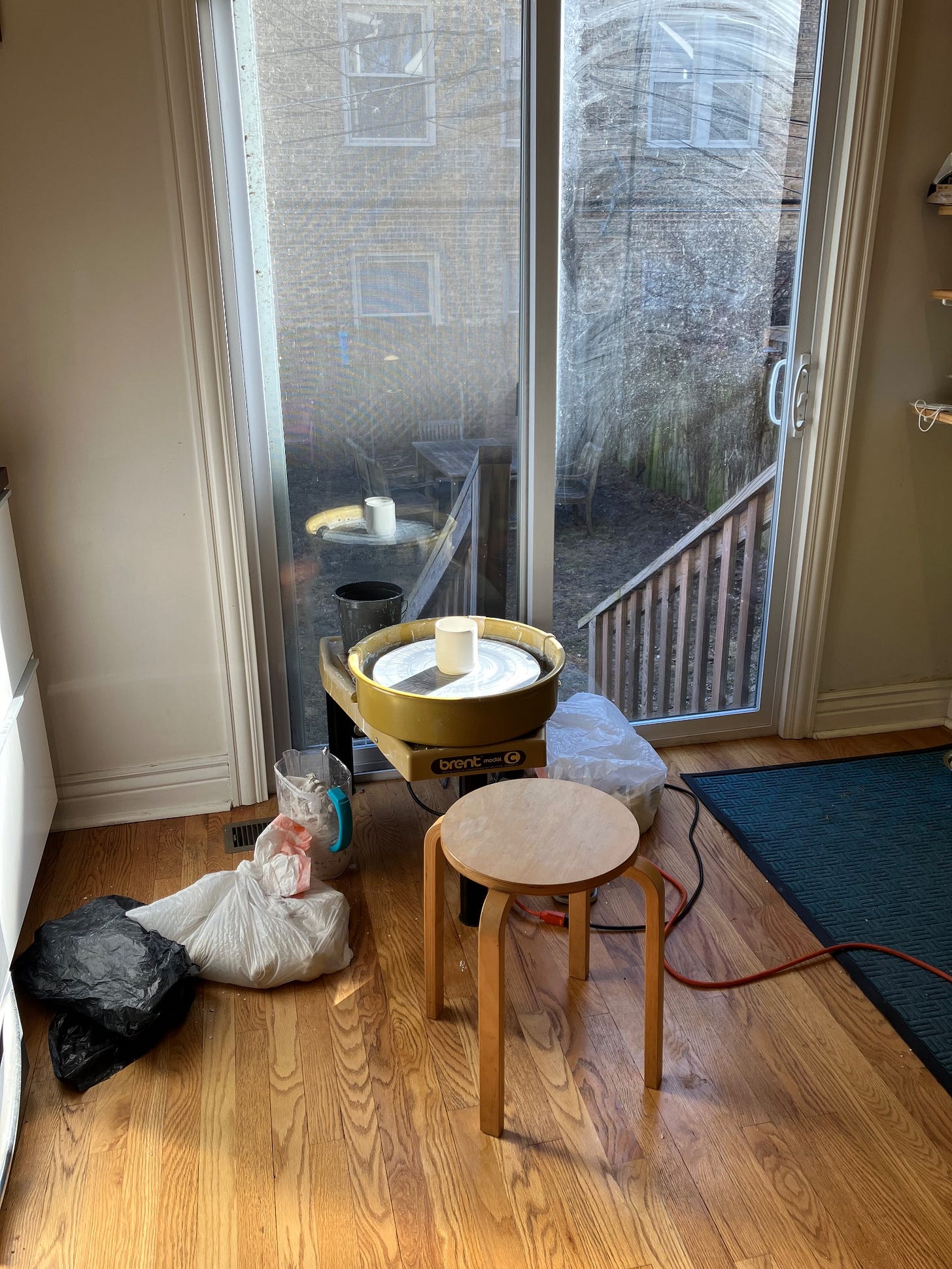Perfect pots
making shit
First of all, biggest thanks to everyone who bought my little joy cups. There will be more available soon, alongside etched anxiety mugs and some other feelings too. They sold out in about 40 minutes, which was pretty wild. I am super grateful and excited to make more work. Also, welcome new subscribers, and those I added (you can unsubscribe at the bottom, I swear, no hard feelings). I write a lot about ceramics here, including when and how you can buy cups and other experiments, but am also working on a new book that will probably be out in 2026 or so, and sometimes I write about that too. My first book, Cost of Living, about my medical debt and employment in the US healthcare system, is currently in paperback, so that’s another way to support my work.
But now, a bit about perfect pots.
In the seventh grade, my mother bought me a used wheel from another potter, a Brent B from the seventies. Brents are now synonymous with art classrooms and production potters, real workhorses, and there are probably tens of thousands or even a hundred thousand of them in circulation, if not many more, but the one I have has a four digit serial number hand painted on the bottom of it—meaning it was among the first few thousand made. I’d been taking after school art classes and throwing on the wheels at school starting in sixth grade or so, but before that, I loved any exposure to clay in art class. I struggled with centering on the Brent wheel at home, but still made pots. Just a few years ago, I bought a new wheel and realized that the old wheel was off-center. I replaced a belt, a flywheel, the assembly on top. It got a new aluminum wheelhead. Now it spins true. It’s funny—for years I blamed myself. But apparently the wheelhead assembly and the belt needed to be replaced. It’s a great wheel, all tuned up now. Sometimes I think of selling it, because the new wheel I bought to replace it goes both lefty and righty, but I don’t think I can. Trimming is what I do best, but I still wreck pots frequently if I trim righty—I have to hold the tool in my left hand to work, and the wheel spins the opposite direction of where it needs to go, so I am working against myself most of the time. I make pots right-handed, because that’s how I originally learned, but trimming lefty on the new wheel has opened up many new possibilities for me. The original wheel still has a pull, though. Maybe I should teach off it instead, if I can make room for that. Probably there is a lesson in all of this.
When I first started dating Ori, just a couple weeks into our relationship, he woke up with me at 4:30 am to unload a kiln so we could drive to a show several hours away (we were in Iowa City; the show was in Chicago). He helped me unload my very hot pots. At one point, the newspaper I was using to wrap my pots started to burn, and so he took everything out of the trunk of my car. “You have to let things cool,” he said. I melted the front of my jacket, which was bright green, filled with feathers, and had been purchased at Farm and Fleet the previous fall. This is probably also a lesson. At the show, he sold all my mugs (!), talked expertly about their value and glazes: the copper reds, the celadons, the salt glazes, all fired to cone 10 perfection in the fancy, semi-automatic Geil kiln at school (then cooled too rapidly in my 2003 Corolla). All I could see were the flaws, where the glazes didn’t do exactly what I wanted, my chemistry problems, but Ori kept talking them up as if they were features, which, of course, they probably were. It still took me many years to figure out that we should be together, get married, be partners forever. But I maybe fell in love with him at that show.
In ceramics, I’m chasing perfect pots, which are not possible, so I want to make imperfect pots, and this, too, is somehow impossible. I fuss over the work in a way that prevents me from making enough of it. I want one perfect yunomi (upright teacup, without a handle). One perfect chawan (low teabowl). I think about entering cup shows and then chicken out (or accidentally-on-purpose miss the deadline). The idea of perfection is a weird dream I’ve been chasing for decades. When I started taking ceramics classes in college, I brought some pieces I’d made at the community center electric kiln in Iowa City. I didn’t know how to take photos of anything, didn’t own a camera, and I felt like the pots would be better in person. Lightweight. That’s the goal for me: to make them lighter than they should be, a sort of surprise for the user. Bunny McBride, who was head of the department at Iowa at the time (yes, that was his legal name—when asked about it, he’d say his parents had a sense of humor), picked up one of the small upright cups I’d brought, each with a little foot, and turned them over in his hand. “You made these,” he said.
“Yes,” I said.
I was intensely nervous. I was so worried my work was too small, too insignificant to be considered. I was making tiny things. A lot of people were making big pots, or installations—one MFA student was making bricks; another was making hundreds of clay chickens; the undergrads made giant platters, big vases, wall installations, big-ass tiles fired in the wood kiln: all sorts of items—and I had all these tiny, slight things. In the end, I was allowed to take Ceramics III/IV, a junior/senior wheel throwing class, then more throwing, where I learned to make big platters and plates, the kind of Iowa aesthetic we learned, in time; kiln construction, ceramic materials and effects, some independent studies. And I made pots, though ultimately majored in English. I tried to take the art prerequisites to major in ceramics, but one of them was design principles I. I failed out because I couldn’t kern by hand—I couldn’t “see” how some spaces between letters were stronger and spaced differently than others; plus there was the x-acto knife, a tool I’d always struggled with using. I hadn’t yet been diagnosed with nonverbal learning disability then. I joke I never learned to handbuild because I started in the throwing class instead, though it is maybe true. I’m getting better at handbuilding now, and I’ve taught others how to handbuild, but it’s not the most natural thing for me. I need more practice, and maybe a little slab roller, which is coming soon, so I can make slab plates and platters. I’ve never learned to kern (or lett). That part’s been okay.
MFA school in writing taught me that the perfect is the enemy of the done, that there’s no way to make the work perfect, and so you just have what you have and you do what you do. But I don’t have that in pots. In ceramics, I have ideal pots in my head, ur-pots, weird ceramics experiments and ideas that I want to render sharp and vivid in real life. I want pots that defy physics: translucent, impossibly lightweight, but very strong, made in ways that make it difficult to understand how they were put together. Lately I have been dreaming about ceramics, the pots I want to make and fire. I’m chasing something that might not even be real anymore, I can’t be sure. But I’m still hoping for it anyway.
In writing, mostly, I just make the work. It’s not my responsibility to know everything. I make the words and put them down and then eventually there are more words. I’ve said before that I feel like there’s a woman in my head and I write down what she says. It’s possible she’s me, but also she’s ruder, more judgy, doesn’t understand the nuance that I have to lay down afterwards. She’s blunter, somehow. I have to make things easier, better, more palatable in revision. I’m not sure exactly who she is or why she’s here, but I write down what she says anyway. It took me a very long time to get to this point, the point where I make the work.
In grad school, I had a professor who was a Buddhist and he said it was above his pay grade to worry about such things. He worried anyway, as is true of probably all writers, a sort of analysis paralysis on the part of his own work at the time, but talking with him in this way made me feel like it was possible and perhaps a good idea to just not worry about the work. There are so many ways in which books can go wrong, long before they have an audience. Marketing, attention, whether or not you get one of those coveted outside publicists who cost $30,000+ (I tried—I was genuinely willing to spend my entire life savings on one of those publicists (before I got extremely lucky with a brilliant publicist my publisher used, internally) but the fancy outside publicist sent me an email telling me I was not literary and thus they were not interested in having me pay $30,000+ to run a campaign), luck of the draw, whatever horrible events are happening in the world at the same time as your book release. God forbid you launch a book during some kind of world crisis—it’s like screaming into a void. So you can’t control any of that. You just do what you’re doing.
But I still want to make perfect pots.


